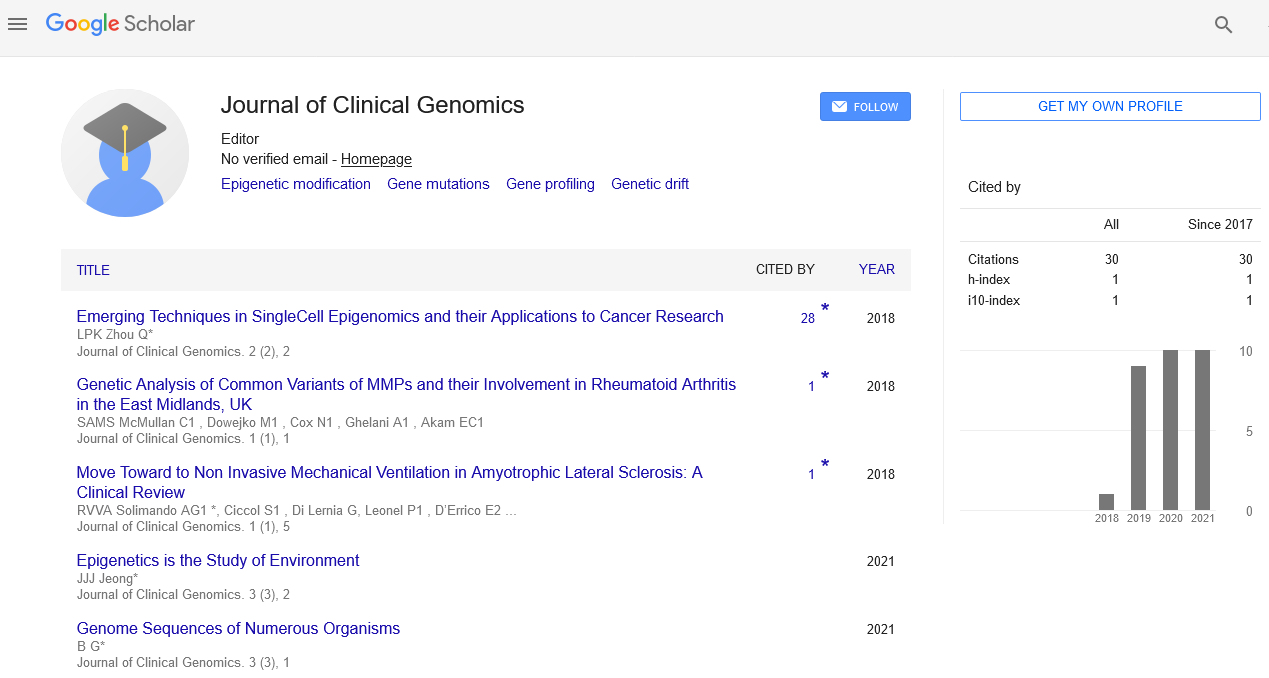Opinion Article, J Clin Genom Vol: 5 Issue: 4
Evaluating Genomic Diversity: Strategies for Copy Number Variation Detection
Lin Pengh*
1Department of Ultrasonography, Women’s Hospital of Nanjing Medical University, Nanjing, China
*Corresponding Author: Lin Pengh,
Department of Ultrasonography,
Women’sHospital of Nanjing Medical University, Nanjing, China
E-mail: lin_pengh@whnmu22.cn
Received date: 22 November, 2023, Manuscript No. JCG-24-125681;
Editor assigned date: 24 November, 2023, PreQC No. JCG-24-125681 (PQ);
Reviewed date: 11 December, 2023, QC No. JCG-24-125681;
Revised date: 19 December, 2023, Manuscript No. JCG-24-125681 (R);
Published date: 26 December, 2023, DOI: 10.4172/JCG.1000141
Citation: Pengh L (2023) Evaluating Genomic Diversity: Strategies for Copy Number Variation Detection. J Clin Genom 5:4
Description
Genomic diversity lies at the core of understanding the intricacies of life, and one important aspect of this diversity is Copy Number Variation (CNV) the presence of variable copies of genomic regions among individuals. Detecting CNVs is essential for unraveling the genetic architecture underlying phenotypic diversity and disease susceptibility. It explores various strategies employed for the detection of CNVs, evaluating their strengths and applications in the quest to comprehend genomic diversity. Copy Number Variation (CNV) involves alterations in the number of copies of a particular genomic segment, ranging from kilobases to megabases in size. CNVs can impact gene dosage, expression levels, and ultimately contribute to phenotypic diversity and disease susceptibility. Robust strategies for detecting CNVs are vital for understanding their role in health and disease.
Comparative Genomic Hybridization (CGH) was one of the pioneering methods for CNV detection. This array-based technique involves comparing the fluorescence intensity of genomic DNA from a test sample against a reference sample. Deviations from equal intensity indicate CNVs. While early versions of CGH had limitations in resolution, advancements in array technology have significantly improved its precision. Single Nucleotide Polymorphism (SNP) Arrays simultaneously analyze SNPs and detect CNVs by assessing changes in allele frequencies. By leveraging the linkage disequilibrium between SNPs, these arrays provide a higher resolution for CNV detection compared to traditional CGH arrays.
SNP arrays are widely used for studying genomic diversity and have proven valuable in disease association studies. Utilizing the vast amount of sequencing data generated by Next Generation Sequencing NGS, read depth analysis involves examining the depth of coverage across the genome. Changes in read depth can signify CNVs. While NGS-based approaches provide high resolution and genome-wide coverage, challenges include accurately distinguishing between different types of structural variations. Fluorescence In-situ Hybridization (FISH) is a cytogenetic technique that utilizes fluorescently labeled DNA probes to target specific genomic regions. It allows for the visualization of CNVs under a microscope. FISH is particularly useful for validating CNVs identified by other methods and provides insights into their spatial organization within chromosomes. Droplet Digital Polymerase Chain Reaction (ddPCR) is a quantitative.
Polymerase Chain Reaction (PCR) technique that partitions DNA samples into thousands of droplets, each containing a single DNA molecule. By counting the number of positive and negative droplets for a specific target, analysts can quantify absolute DNA copy number. ddPCR is advantageous for its sensitivity and precision in detecting CNVs. Whole Genome Sequencing (WGS) involves sequencing the entire genome, providing comprehensive coverage for CNV detection. By analysing the distribution and depth of sequenced reads, WGS offers high sensitivity and specificity. However, the cost and data analysis complexity remain challenges for widespread adoption. Understanding CNVs is essential for unraveling their role in various diseases.
Detection strategies play a pivotal role in disease association studies, helping identify genomic regions associated with increased disease risk. Assessing genomic diversity across populations is essential for understanding evolutionary processes and population-specific CNVs. Detection strategies enable studies to explore the distribution of CNVs and their potential adaptive significance. CNV detection is increasingly used in clinical settings for diagnosing genetic disorders. Accurate identification of CNVs is essential for providing patients with precise genetic information and informing personalized treatment strategies. The detection of CNVs is instrumental in pharmacogenomic studies, where genetic variations influence individual responses to medications. Identifying CNVs associated with drug metabolism genes is essential for tailoring treatment regimens.
Conclusion
In the pursuit of understanding genomic diversity, strategies for Copy number variation detection plays a pivotal role in decoding the genetic intricacies that contribute to phenotypic variation and disease susceptibility. From array-based methods to advanced sequencing technologies, each approach has its strengths and applications. As technology continues to evolve, the integration of multiple detection strategies and the development of more precise and cost-effective methods will further enhance the ability to explore the vast landscape of genomic diversity and its implications for human health and evolution.
 Spanish
Spanish  Chinese
Chinese  Russian
Russian  German
German  French
French  Japanese
Japanese  Portuguese
Portuguese  Hindi
Hindi 